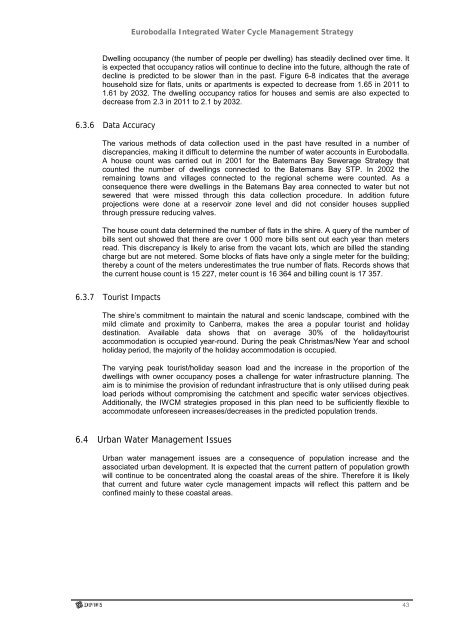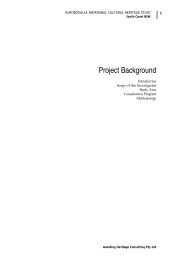Eurobodalla Integrated Water Cycle Management Strategy
Eurobodalla Integrated Water Cycle Management Strategy
Eurobodalla Integrated Water Cycle Management Strategy
You also want an ePaper? Increase the reach of your titles
YUMPU automatically turns print PDFs into web optimized ePapers that Google loves.
<strong>Eurobodalla</strong> <strong>Integrated</strong> <strong>Water</strong> <strong>Cycle</strong> <strong>Management</strong> <strong>Strategy</strong><br />
Dwelling occupancy (the number of people per dwelling) has steadily declined over time. It<br />
is expected that occupancy ratios will continue to decline into the future, although the rate of<br />
decline is predicted to be slower than in the past. Figure 6-8 indicates that the average<br />
household size for flats, units or apartments is expected to decrease from 1.65 in 2011 to<br />
1.61 by 2032. The dwelling occupancy ratios for houses and semis are also expected to<br />
decrease from 2.3 in 2011 to 2.1 by 2032.<br />
6.3.6 Data Accuracy<br />
The various methods of data collection used in the past have resulted in a number of<br />
discrepancies, making it difficult to determine the number of water accounts in <strong>Eurobodalla</strong>.<br />
A house count was carried out in 2001 for the Batemans Bay Sewerage <strong>Strategy</strong> that<br />
counted the number of dwellings connected to the Batemans Bay STP. In 2002 the<br />
remaining towns and villages connected to the regional scheme were counted. As a<br />
consequence there were dwellings in the Batemans Bay area connected to water but not<br />
sewered that were missed through this data collection procedure. In addition future<br />
projections were done at a reservoir zone level and did not consider houses supplied<br />
through pressure reducing valves.<br />
The house count data determined the number of flats in the shire. A query of the number of<br />
bills sent out showed that there are over 1 000 more bills sent out each year than meters<br />
read. This discrepancy is likely to arise from the vacant lots, which are billed the standing<br />
charge but are not metered. Some blocks of flats have only a single meter for the building;<br />
thereby a count of the meters underestimates the true number of flats. Records shows that<br />
the current house count is 15 227, meter count is 16 364 and billing count is 17 357.<br />
6.3.7 Tourist Impacts<br />
The shire’s commitment to maintain the natural and scenic landscape, combined with the<br />
mild climate and proximity to Canberra, makes the area a popular tourist and holiday<br />
destination. Available data shows that on average 30% of the holiday/tourist<br />
accommodation is occupied year-round. During the peak Christmas/New Year and school<br />
holiday period, the majority of the holiday accommodation is occupied.<br />
The varying peak tourist/holiday season load and the increase in the proportion of the<br />
dwellings with owner occupancy poses a challenge for water infrastructure planning. The<br />
aim is to minimise the provision of redundant infrastructure that is only utilised during peak<br />
load periods without compromising the catchment and specific water services objectives.<br />
Additionally, the IWCM strategies proposed in this plan need to be sufficiently flexible to<br />
accommodate unforeseen increases/decreases in the predicted population trends.<br />
6.4 Urban <strong>Water</strong> <strong>Management</strong> Issues<br />
Urban water management issues are a consequence of population increase and the<br />
associated urban development. It is expected that the current pattern of population growth<br />
will continue to be concentrated along the coastal areas of the shire. Therefore it is likely<br />
that current and future water cycle management impacts will reflect this pattern and be<br />
confined mainly to these coastal areas.<br />
43

















